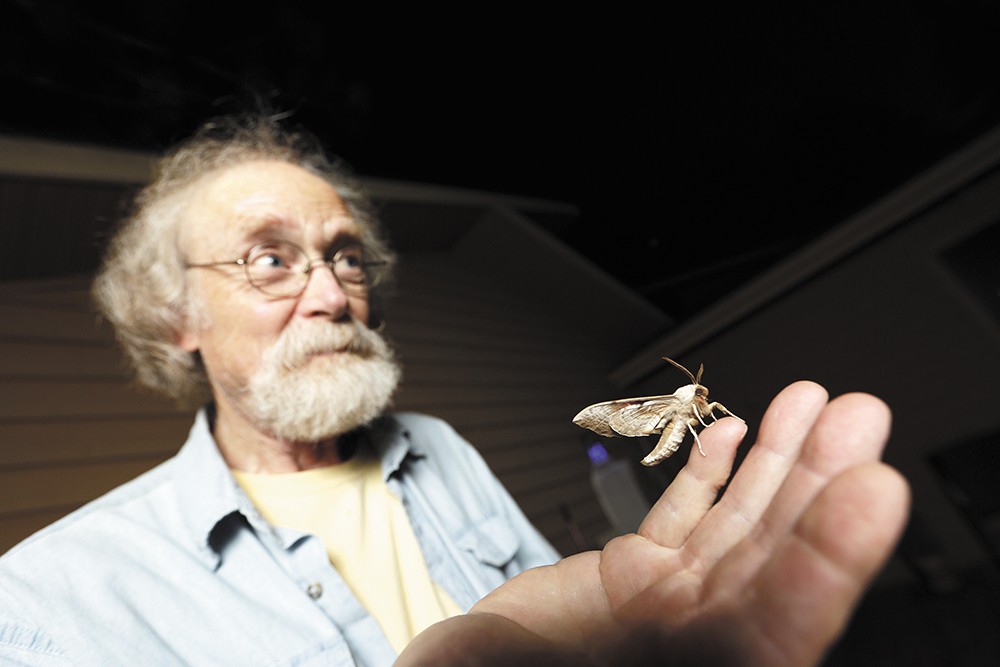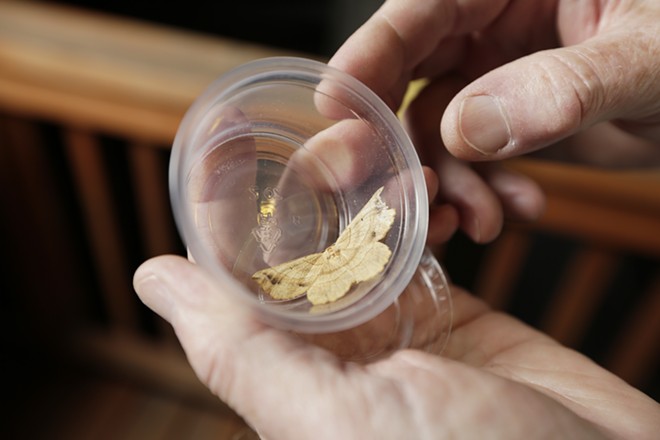On any given day, if you look in Carl Barrentine's fridge, you're liable to find tupperware containers filled not with leftovers, but with brown, living, winged things: moths.
During an evening visit to his Hangman Hills home south of Spokane, Barrentine pulls out two containers, each holding a different large moth caught the night before.
The wings on one look remarkably like the brown bark patterns on evergreen trees in the area. The other, maybe 3 or 4 inches across, is commonly known as the Western One-Eyed Sphinx, for a distinct circular mark on each wing that looks like an eyeball. As they sit on the table and start to warm up, the two start batting their wings, ready to be released into the night.
Each was attracted to one of the retired biologist's traps. With the use of simple white sheets, a blacklight and egg cartons where the critters can hide when they want to rest, Barrentine says he can literally catch hundreds of the bugs in his sleep.
"Moths are very cryptic. You don't see moths during the day because they hide," he says. "So I give them places to hide."
He collects his daily catch in the early hours near dawn, tapping the bugs off of the cartons and putting the ones he hasn't seen yet into the same little plastic containers you'd normally use to take sauce with a to-go order.
Once he's got them chilled down so they're a little slow moving, Barrentine carefully photographs each one, then releases it. He uploads his pictures to mothing Facebook groups and lepsnap.fieldguide.net, to share with others who are fascinated by the lepidoptera order of insects.
Believe it or not, he's among a very passionate group of scientists and citizen scientist "moth-ers" around the world who get a kick out of observing moths in their own backyards and identifying them, which is harder than it sounds.
Guidebooks for this part of the world just don't exist for moths, Barrentine says. That's partly why he's helping photograph and log the species he finds, so he can help others identify the bugs they see.
"You feel like you're discovering things! It's so 19th century in many respects," he says. "As an educator that's what I was really all about, is to get people to see things that they don't normally see, that have been there all the time. And you go, 'Oh my god, how could I have overlooked that?'"
So far this year, Barrentine has identified more than 340 different species of moth just from his backyard traps. For context, there are about 180 species of butterfly in the Pacific Northwest, but Barrentine says there are thousands of moths waiting to be logged.
Before moving to the area last fall with his wife, Barrentine spent several years practicing his hobby in North Dakota, where they both taught at the University of North Dakota. There, he identified more than 800 species, and found another 90 he couldn't identify.
"That's so exciting! Most people when they think of moths, they think, 'Eh, it's just a little brown thing,'" Barrentine says, "but you start looking at them carefully and they're really not like that at all."
For years now, Barrentine has helped host events to get other members of the public interested in moths through National Moth Week. This year's week lasts through July 29, and includes events around the world created by a group of similarly passionate people and scientists.
In addition to hosting walks to point out moths in various park systems, Barrentine says anyone can set up a light and a cloth hamper in their backyard and catch some moths. Moth Week's citizen science efforts are meant to get people interested in learning more.
"Kids love this stuff," Barrentine says. "You hang a light, things come out of the dark and they're icky and wonderful and we get to look at them."
When Barrentine heads down to his own backyard sheet trap around 10 pm, some of those other creatures lured by the light are on display. Beetles with colorful wings bask in the light, and another long bug with menacing pincers sits on the ground.
"Look at this lovely thing, oh my gosh, isn't that great?" he says, picking up the Giant Water Bug. "In the Midwest they call another species of this a toe biter, because look at the claws on this thing!"
While looking at the sheet hanging from his deck, Barrentine realizes he may be in luck.
"There's a little moth here, I don't think I've seen that one, it's a lovely one," he says, going to grab a container. "This is why you gotta do this stuff every night."
By morning, he reports the little moth turned out to be Ethmia marmorea, a rarely reported species.
Every moth serves an important role in its ecological system, he says, whether as a food source for birds and other creatures or as pollinators, and many species are intimately tied to specific plant species.
"As the environment changes, these are indicators for what's going on," Barrentine says. "You get looking closely and I'm just awed. That's what it is really, a sense of awe and wonder."♦
Information on National Moth Week events being hosted around the world is available at nationalmothweek.org.



